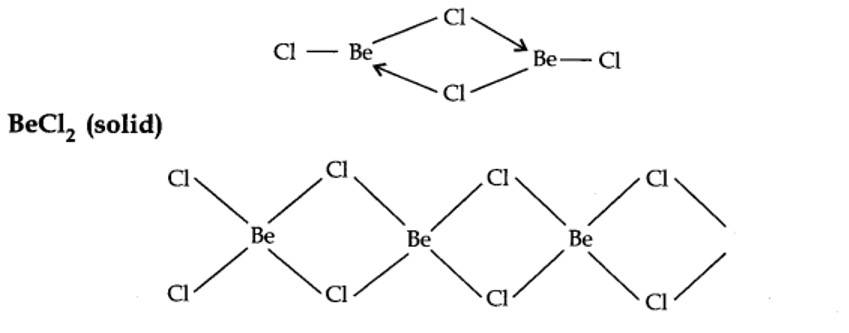The S Block Elements
Get insights from 95 questions on The S Block Elements, answered by students, alumni, and experts. You may also ask and answer any question you like about The S Block Elements
Follow Ask QuestionQuestions
Discussions
Active Users
Followers
New answer posted
6 months agoContributor-Level 10
BeCl2 (vapour)
In the vapour state, it exists as a chloro-bridged dimer.

New answer posted
6 months agoContributor-Level 10
(i) Caustic soda
It is used in (a) the manufacture of soap, paper, artificial silk and a number of chemicals, (b) in petroleum refining, (c) in the purification of bauxite, (d) in the textile industries for mercerising cotton fabrics, (e) for the preparation of pure fats and oils, and (f) as a laboratory reagent.
(ii) Sodium carbonate
(a) It is used in water softening, launderingand cleaning.
(b) It is used in the manufacture of glass, soap, borax and caustic soda.
(c) It is used in paper, paints and textileindustries.
(d) It is an important laboratory reagent bothin qualitative and quantitative analysis
(iii) Quick lime
(a) It is an i
New answer posted
6 months agoContributor-Level 10
(i) Magnesium is burnt in air to form magnesium oxide and magnesium nitride.
2Mg + O2 → 2MgO
3Mg + N2 → Mg3N2.
(ii) Quick lime is heated with silica above 1273 K to obtain calcium silicate
CaO+SiO2 → CaSiO3.
(iii) Chlorine reacts with slaked lime to form calcium hypochlorite- a constituent of bleaching powder.
2Ca (OH)2 + 2Cl2 → CaCl2 + Ca (OCl)2 + 2H2O.
(iv) Calcium nitrate is heated to obtain CaO, NO2 and O2.
2Ca (NO3)2→2CaO+4NO2+O2.
New answer posted
6 months agoContributor-Level 10
(i) Sodium metal is manufactured by electrolysis of a fused mass of NaCl 40% and CaCl2 60% in Down's cell at 873 K, using iron as cathode and graphite as anode. Na is liberated at the cathode.
At cathode:
Na+ + e– → Na (l)
At anode:
2Cl– (melt) → Cl2 (g) + 2e–.
(ii) Sodium hydroxide is manufactured by electrolysis of an aqueous solution of NaCl (brine) in Castner-Kellner cell.
At cathode:
Na+ + e– → Na
2Na + Hg → Na – Hg + 2H2O
2Na- Hg + 2H2O → 2NaOH +H2 +Hg
At anode:
Cl– – e– → Cl
Cl + Cl→ Cl2
(iii) Sodium peroxide:
Sodium is heated in excess of oxygen to form sodi
New answer posted
6 months agoContributor-Level 10
(a) Nitrates of both group 1 and group 2 elements are soluble in water because hydration energy is more than the lattice energy.
Nitrates of both group 1 and group 2 elements are thermally unstable but they decompose differently except LiCO3 e.g.
2NaNO3 →2NaNO2 + O2
2KNO3 →2KNO2 + O2
4LiNO3 →2MgO + 4 NO2 + O2
2Mg (NO3)2 →2MgO + 4NO2 + O2
(b) Carbonates of group 1 elements are soluble in water except Li2CO3 They are also thermally stable except Li2CO3.
Li2CO3 →Li2O + CO2
Group 2 carbonates are insoluble in water because their lattice energy is higher than hydration energy.
Thermal stability of carbonates of group 2 inc
Taking an Exam? Selecting a College?
Get authentic answers from experts, students and alumni that you won't find anywhere else
Sign Up on ShikshaOn Shiksha, get access to
- 65k Colleges
- 1.2k Exams
- 679k Reviews
- 1800k Answers
